Bitcoin (BTC) begins a new week with a bullish surge above $22,000 as the Federal Reserve injects liquidity into the United States economy.
In a move which can rival any classic Bitcoin comeback, BTC/USD is up a full 15% off the two-month lows seen on March 10.
The volatility — and at least temporary relief for bulls — is all due to events in the U.S. after the failure of one bank and the forced halting of another’s operations.
Silicon Valley Bank and Signature Bank are the latest victims in a brutal year for financial institutions under the Fed’s rising interest rates — will the trend continue?
Despite Signature being crypto focused and a major on-ramp from fiat, crypto markets have so far seen no reason to abandon optimism at the prospect of the Fed providing fresh money.
Not everyone, however, believes that this constitutes a “pivot” on interest rate hikes or overall policy.
As the dust continues to settle and news floods in from the ongoing events, Cointelegraph breaks down the main factors moving BTC price in the short term.
Fed bails out Silicon Valley Bank depositors
The story of the moment is of course the fallout from Silicon Valley Bank (SVB) failing late last week.
Swallowing hundreds of billions of dollars in deposits, SVB was forced to take a giant $1.8 billion loss thanks to parking consumer funds in mortgage-backed securities, the price of which also suffered thanks to the Fed’s rate hikes.
A snowball effect soon began as depositors became wary that something might be wrong in terms of liquidity. Everyone attempted to withdraw from SVB at once, and the funds were unavailable, necessitating sale of assets at a loss and an emergency funding round which ultimately failed.
The result has come in the form of the Fed stepping in to backstop depositors’ money. On March 12, it announced the “Bank Term Funding Program” (BTFP).
“Depositors will have access to all of their money starting Monday, March 13,” an accompanying joint statement from the Department of the Treasury, Fed Board and Federal Deposit Insurance Corporation (FDIC) confirmed.
“No losses associated with the resolution of Silicon Valley Bank will be borne by the taxpayer.”
@federalreserve @USTreasury @FDICgov issue statement on actions to protect the U.S. economy by strengthening public confidence in our banking system, ensuring depositors’ savings remain safe: https://t.co/YISeTdFPrO
— Federal Reserve (@federalreserve) March 12, 2023
As market commentators were quick to point out, the decision effectively marks a return to Fed liquidity injections — quantitative easing (QE) — whereas before, liquidity was being withdrawn from the U.S. economy.
Risk assets rallied instantly on the news, as increasing liquidity ultimately increases investor appetite for risk.
Crypto was no exception, despite U.S. authorities announcing the sudden closure of Signature Bank in a move which some argue was a direct attempt to stop crypto markets capitalizing on the SVB aftermath.
“We are also announcing a similar systemic risk exception for Signature Bank, New York, New York, which was closed today by its state chartering authority. All depositors of this institution will be made whole. As with the resolution of Silicon Valley Bank, no losses will be borne by the taxpayer,” the same joint statement read.
Reacting to the creation of the BTFP, popular commentator Tedtalksmacro described it as a form of “stealth QE.”
“Unofficial quantitative easing begins on Monday. This is so bullish,” part of subsequent Twitter posts added.
“TL;DR the Fed’s balance sheet will expand and that will increase USD liquidity.”
As Cointelegraph reported, crypto as a whole is highly sensitive to central bank liquidity trends — and not just those in the U.S.
Among those underlining this is Arthur Hayes, former CEO of derivatives exchange BitMEX, who in a blog post earlier in the year spelled out how changing liquidity conditions would likely impact Bitcoin and altcoin performance.
Now, he was conspicuously bullish.
“Get ready for a face ripping rally in risk assets. MONEY PRINTER GO BRRR!!!” he told Twitter followers about the BTFP in one of several posts on March 12.
Speculation gathers over Fed interest rate “pivot”
With liquidity returning to the market, it was not just crypto wondering about the fate of the Fed’s quantitative tightening (QT) policy in place for the past 18 months.
Speculation was rampant on the day that this month’s decision on interest rate adjustments may yield either a reduction or see the Fed leave the current rate unchanged.
Previously, markets had been swinging between a 0.25% and a 0.5% increase to the benchmark rate at the March 22 meeting of the Federal Open Market Committee (FOMC).
“In light of the stress in the banking system, we no longer expect the FOMC to deliver a rate hike at its next meeting on March 22,” Goldman Sachs economist Jan Hatzius wrote in a note on March 12 quoted by CNBC and others.
David Ingles, chief markets editor at Bloomberg TV, interpreted the comments as Goldman considering CPI a “non event.”
Cointelegraph contributor Michaël van de Poppe, founder and CEO of trading firm Eight, looked closer to home, noting that the coming week would produce another price catalyst in the form of February’s Consumer Price Index (CPI) inflation data.
“’QE’ and ‘Bailout’ for the banks, which means temporary relief + potential good CPI and no more rate hikes (or 25bps) is fuel,” he wrote as part of Twitter comments on March 13.
“Markets now waiting for CPI to give the green light,” popular trading and analytics account Daan Crypto Trades continued.
“If CPI comes in hot we’ll see some chaos as we’d basically have an increasing CPI + Easing Fed. If CPI comes in below estimates I don’t see a reason for the market to hold back.”
More cautious was Alasdair Macleod, who in light of the BTFP decision warned against assuming that the Fed had abandoned QT for good.
“Initial market reaction to banking crisis is based on perceived Fed pivot. But this could be a mistake,” he tweeted.
“Irrespective of Fed monetary policy, contracting bank credit forces up the price of loans, if you can get one. Monitor money markets!”
According to CME Group’s FedWatch Tool, overall expectations still favored a further hike rather than a stagnating benchmark rate on March 22. 0.5%, however, was off the table.
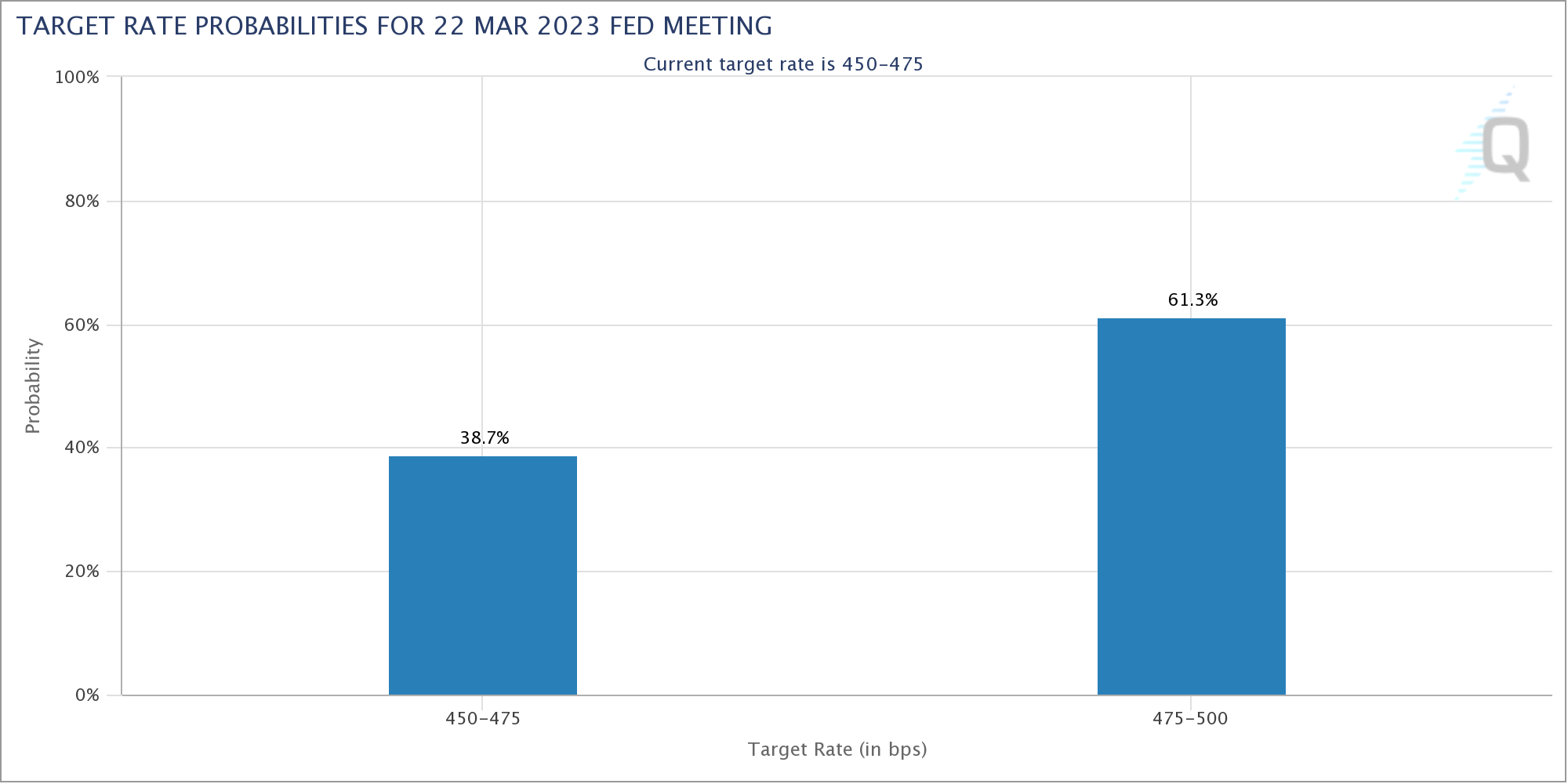
BTC price jumps to $22.7K in blistering comeback
With that, Bitcoin was in a clearly bullish mood during the Asia trading session on March 13.
Ahead of the Wall Street open, BTC/USD traded at around $22,100 at the time of writing, having hit local highs of $22,775 on Bitstamp, according to data from Cointelegraph Markets Pro and TradingView.
The bulk of the recovery from its March 10 lows of under $20,000 came following the Fed liquidity announcement, but this nonetheless fully erased any trace of the SVB implosion.
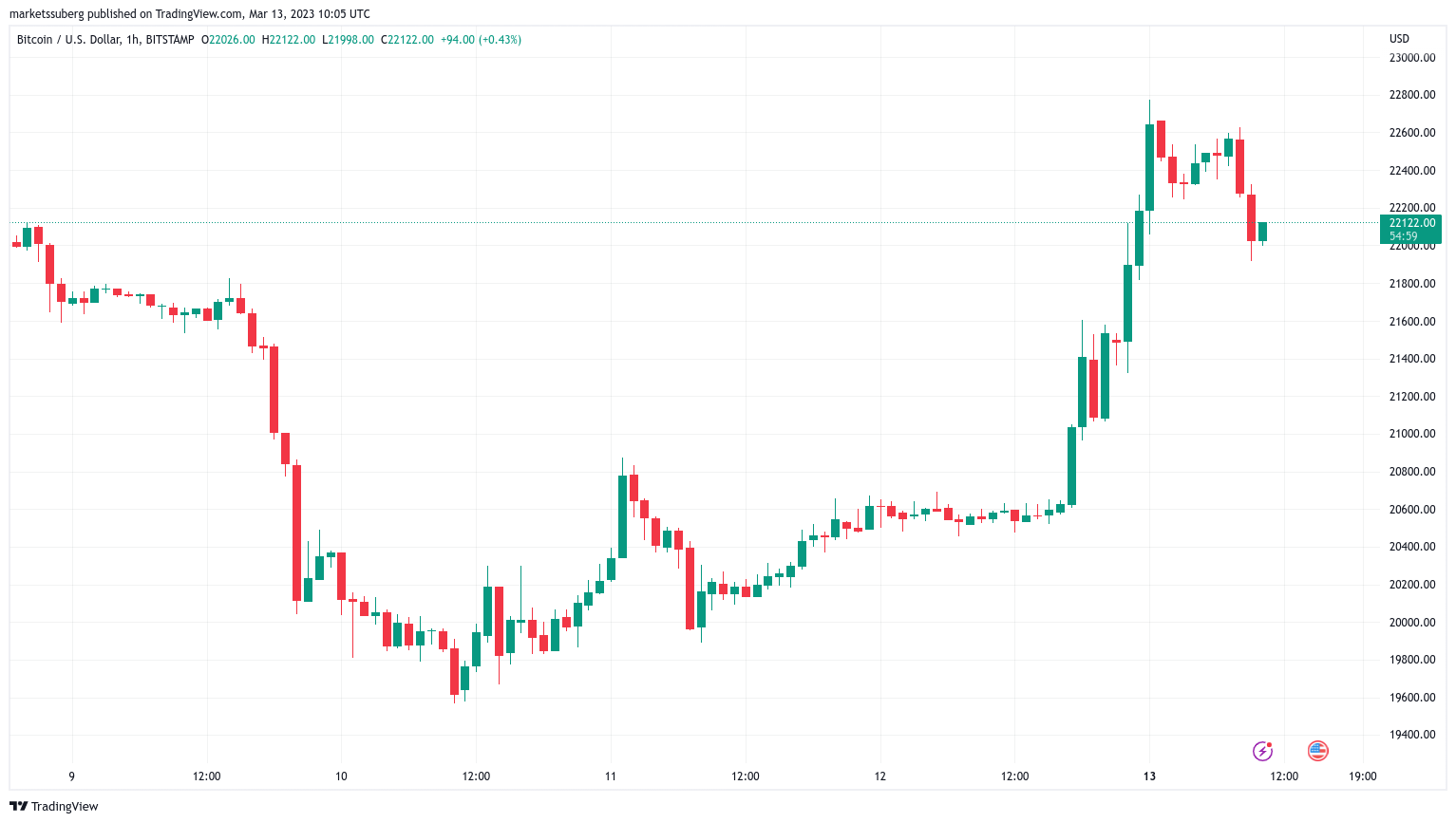
“Bitcoin recovered from the biggest US bank collapse since 2008… in just 3 days,” popular commentator Bitcoin Archive summarized.
Among traders, targets remained varied as volatility still moved BTC/USD up and down prior to the open.
Van de Poppe argued that $21,300 must hold in order to facilitate a long trade, this nonetheless potentially reaching $23,700.
“22.7K liquidity looks ripe for the taking,” fellow trader Crypto Chase continued.
“For any local longs, stops below 21K should be safe IMO. Back below there wouldn’t make much sense to me if this is going to keep ripping.”
Full-time trader Jackis meanwhile noted that last week’s low had exactly matched the 0.618 Fibonacci retracement level from the 2023 highs above $25,000.
“No surprise we are pumping off of major monthly support,” Credible Crypto added about current price behavior on 4-hour timeframes.
Bitcoin’s weekly close thus came in far higher than expected at more than $22,000. For trader and analyst Rekt Capital, this “likely” put pay to the bearish double top pattern previously playing out on weekly timeframes.
“Weekly Close above $21770 likely invalidates the Double Top,” part of a tweet on March 12 read.
Further analysis nonetheless gave April as the nearest point that Bitcoin could begin to effect a longer-term trend change.
“Great BTC reaction from ~$20000, the Range Low of this Macro Range,” Rekt Capital wrote.
“As long as ~$20000 holds, $BTC has a chance at challenging the Macro Downtrend in the coming weeks once again At the earliest this April.”
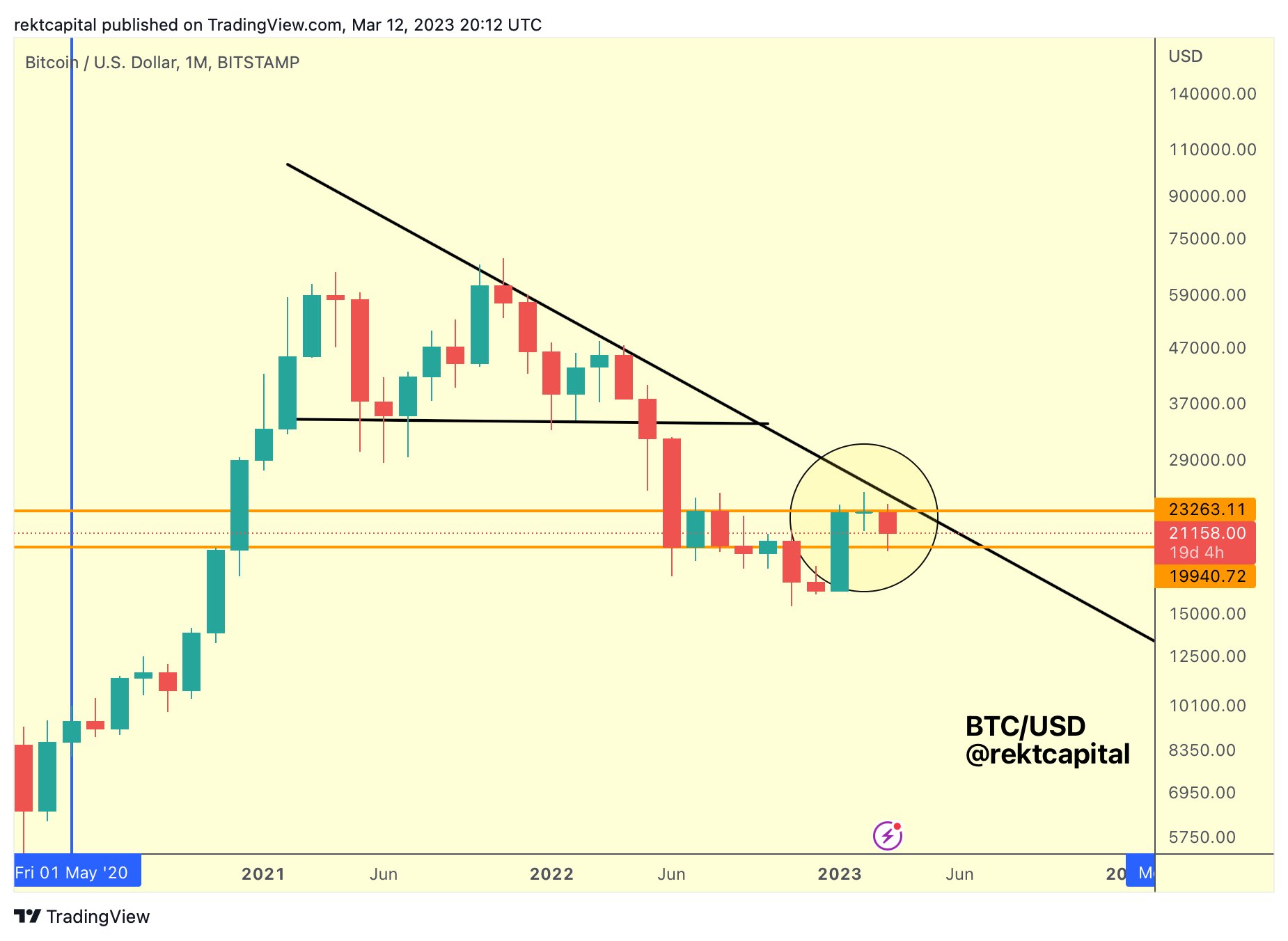
USDC looks to regain $1 peg
In what could make investors breathe a sigh of relief this week, an early crypto casualty of the SVB implosion was back in the running on March 13.
USD Coin (USDC), the second-largest stablecoin by market cap, had practically regained its U.S. dollar peg at the time of writing.
Having previously dipped 20%, USDC traded at $0.99 on Bitstamp, as assurances from issuer Circle helped calm existing panic.
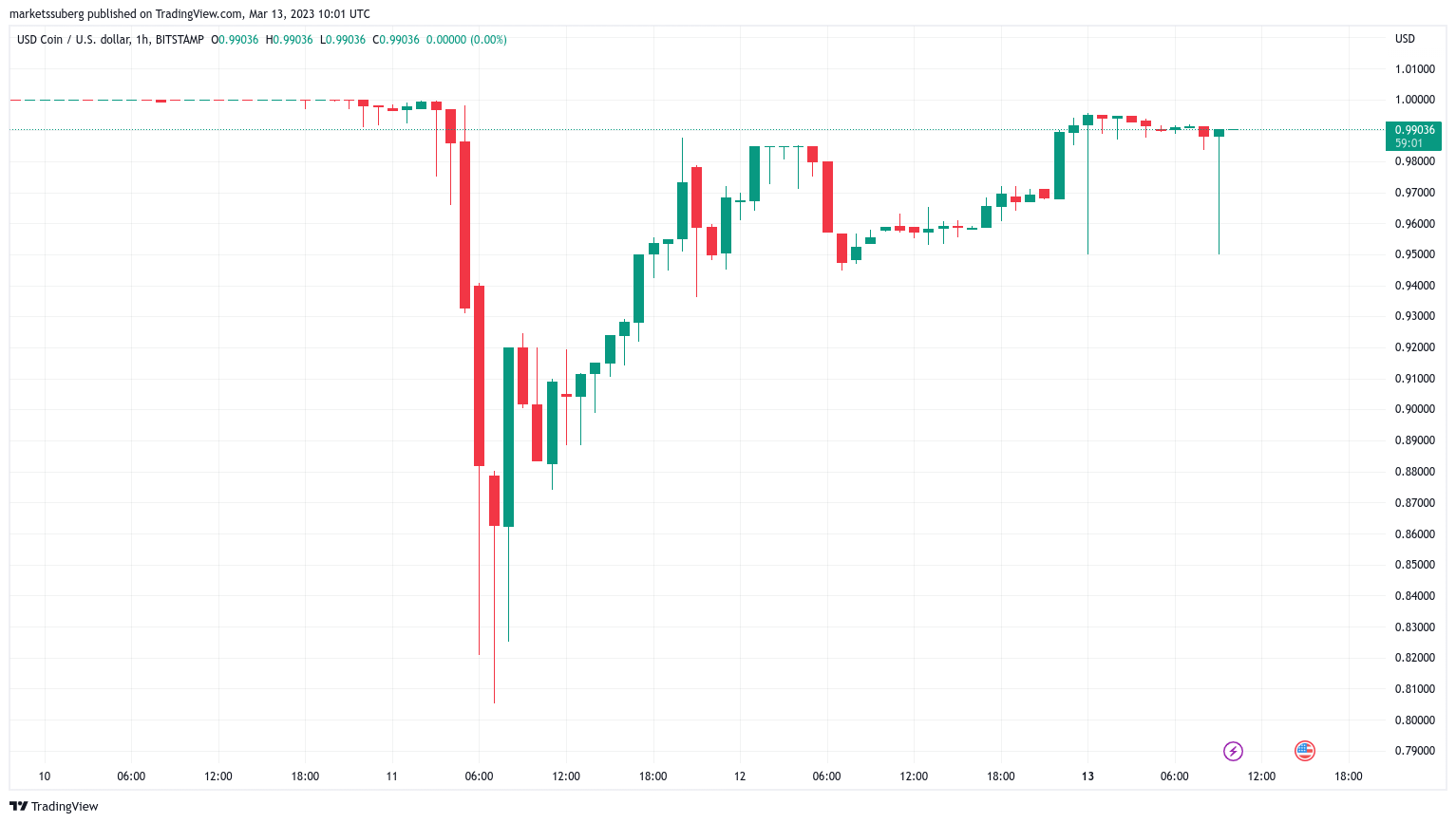
In a Twitter thread on March 12, CEO Jeremy Allaire confirmed that BNY Mellon and an unnamed new banking partner would take over from where Signature and SVB, which swallowed over $3 billion of its reserves, abruptly left off.
“Trust, safety and 1:1 redeemability of all USDC in circulation is of paramount importance to Circle, even in the face of bank contagion affecting crypto markets,” he added in a press release, praising the actions of the Fed and U.S. lawmakers.
Largest U.S. exchange Coinbase meanwhile confirmed that USDC conversions would begin on March 13.
“Despite the turbulence we have seen in the traditional banking sector recently, Coinbase continues to operate as usual. At Coinbase all client funds continue to be safe and accessible including USDC conversions which will resume on Monday,” it tweeted.
Other major stablecoins which had come unstuck in step with USDC also attempted to regain their dollar pegs, with Dai (DAI) at $0.989 and USDD (USDD) at $0.986, respectively.
Given the changes in stable coins and banks, #Binance will convert the remaining of the $1 billion Industry Recovery Initiative funds from BUSD to native crypto, including #BTC, #BNB and ETH. Some fund movements will occur on-chain. Transparency.
— CZ Binance (@cz_binance) March 13, 2023
Changpeng Zhao, CEO of largest global exchange Binance, additionally announced the conversion of some of its own stablecoin, Binance USD (BUSD) to Bitcoin, Ether (ETH) and its in-house Binance Coin (BNB) as part of its existing “Industry Recovery Fund.”
“With nearly $1B untapped, this means the market will have extreme buying pressure soon,” part of a reaction from on-chain data researcher The Data Nerd read.
Sentiment rebounds as “short squeeze” risk rises
In a reflection of the extent to which crypto market sentiment remains extremely sensitive to macro events, the Crypto Fear & Greed Index returned to “fear” for the first time in two months on March 10.
Related: Watch these 5 cryptocurrencies for a potential price rebound next week
The latest events saw a dramatic turnaround, with the Index’s score going from 33/100 to 49/100 — classed as “neutral” — in a single day.
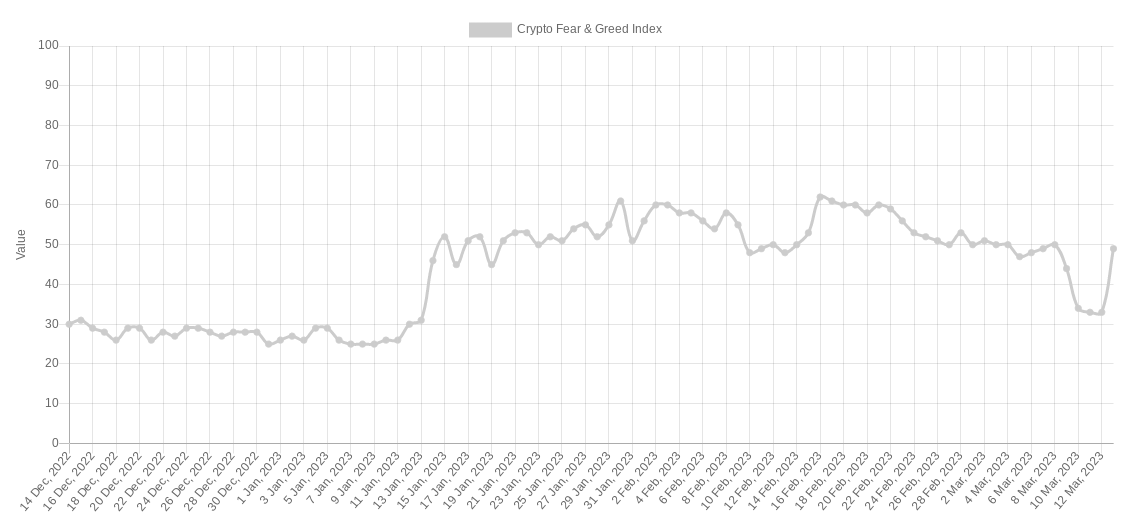
On derivatives exchanges, however, bearishness remains. Over the weekend, funding rates hit their lowest since the aftermath of the FTX implosion in November 2022, data from on-chain analytics firm Glassnode shows.
“Longs are being paid to be long,” Tedtalksmacro summarized.
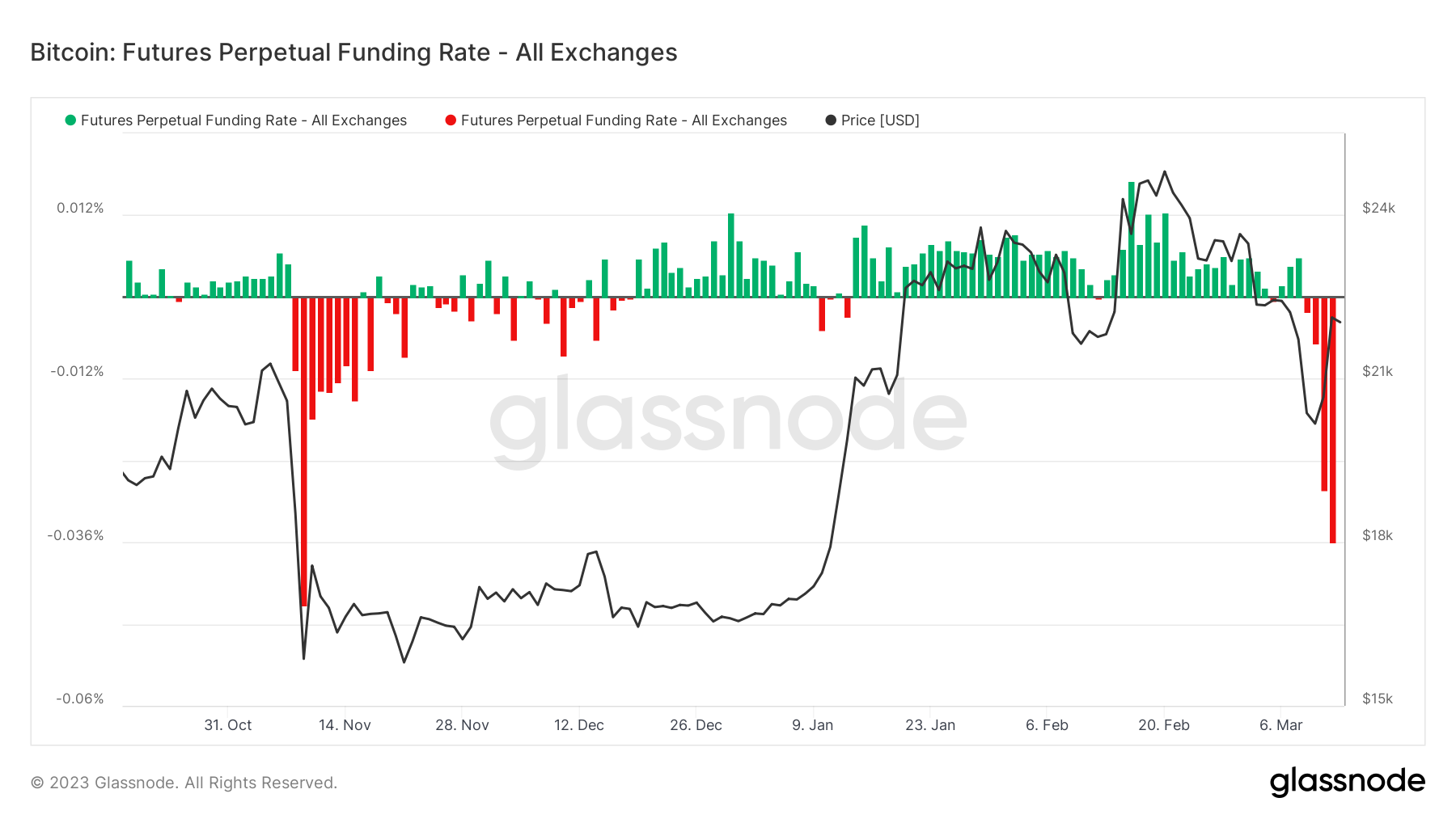
Overly negative funding rates have the ability to spark a “short squeeze” — an event where shorts are liquidated en masse in a cascade-like domino effect as the market majority expects price to continue falling.
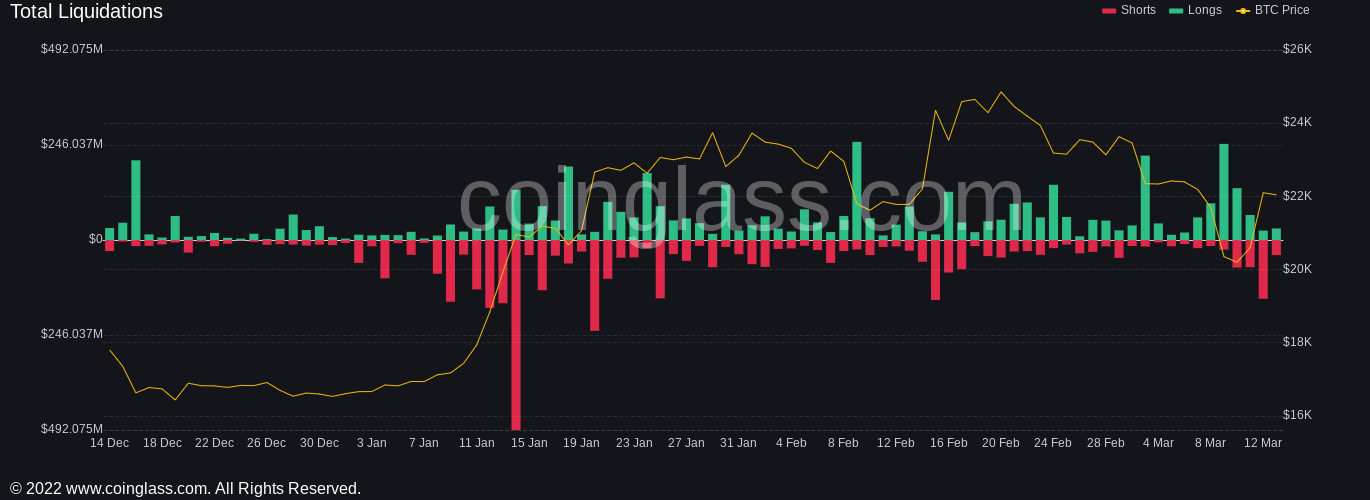
Cross-crypto short liquidations already totaled more than $150 million on March 12 alone, according to data from Coinglass, with the March 13 tally at $39 million.
The views, thoughts and opinions expressed here are the authors’ alone and do not necessarily reflect or represent the views and opinions of Cointelegraph.
